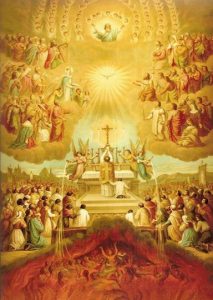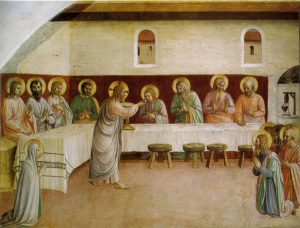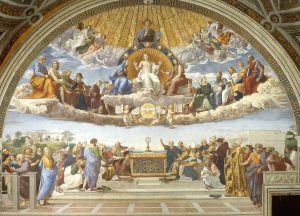 In the early 2nd century, the great bishop and theologian whom we know today as St. Ignatius of Antioch, wrote a series of letters to several important Christian cities while a prisoner on route to his eventual martyrdom in Rome. The texts of these stunning letters have been persevered to this day, and they provide a fascinating window into the faith of the early Church.
In the early 2nd century, the great bishop and theologian whom we know today as St. Ignatius of Antioch, wrote a series of letters to several important Christian cities while a prisoner on route to his eventual martyrdom in Rome. The texts of these stunning letters have been persevered to this day, and they provide a fascinating window into the faith of the early Church.
Toward the end of his letter to the Ephesians, St. Ignatius admonishes the faithful of that city to remain obedient to their bishop and priests, and then encourages them with powerful words concerning the Eucharist, which he calls: “the medicine of immortality, and the antidote to prevent us from dying, but [which causes] that we should live forever in Jesus Christ.”
What a beautiful way to refer to the Eucharist: The Medicine of Immortality! It seems to me that St. Ignatius is merely summarizing the teaching of Our Lord himself, who said: “I am the living bread which came down from heaven; if any one eats of this bread, he will live forever; and the bread which I shall give for the life of the world is my flesh” (John 6:51).
The Eucharist is indeed powerful medicine for the soul, and a pledge of the future resurrection of our bodies. But as we know well from our experience, sometimes the medicines with the strongest healing effects can be the medicines which are most easily abused. This is why strong medicines come with serious warning labels. And the Eucharist is no different.
St. Paul gives us precisely such a “warning label” in his first letter to the Corinthians, when he explains:
Whoever, therefore, eats the bread or drinks the cup of the Lord in an unworthy manner will be guilty of profaning the body and blood of the Lord. Let a man examine himself, and so eat of the bread and drink of the cup. For anyone who eats and drinks without discerning the body eats and drinks judgment upon himself. (1 Cor. 11:27-29)
Let’s unpack what St. Paul is telling us here. Just as a strong medicine might bring life and health to one patient whose condition warrants it, that very same medicine could cause damage and even death in another patient whose condition is quite different, and is not so disposed to receive that medicine’s effects.
This is exactly what Bishop Matano has in mind in his Pastoral Letter, when he reminds us:
Belief in the Eucharistic presence of Christ also means that we approach the Holy Eucharist properly disposed, that is, not conscious of serious sin that requires that we avail ourselves of the Sacrament of Reconciliation, Confession, before the reception of Holy Communion.
In my work in the parish, I try to remind people that if they are at Mass but know that they have a mortal sin on their soul and need to get to confession, then the very best thing they can do for themselves is actually not receive Holy Communion! This advice is not meant to be harsh or exclusionary. Rather, it is actually like the advice of a good doctor who says to his patient: “this medicine is not for you right now, but don’t worry, I have something else for you that will help you get better!” If they want, I allow them to come up a receive a simple blessing from the priest instead, until they can arrange to make it to the Sacrament of Confession.
Ultimately, if we want to grow in our love of the Real Presence of Christ in the Eucharist and to see the Eucharist as that medicine of immortality which we profess It to be, we are in desperate need to recover the practice of regular sacramental confession. These two Sacraments go hand in hand.
I think Bishop Matano gives us two important keys to bringing this about.
First, he reminds us that the Year of the Eucharist is meant to support parents in their role as the primary religious instructors of their children. Participation at Holy Mass, love of the Eucharist, and regular confession can only be cultivated at the Diocesan-wide level if our parents insist on making such practices a normal part of their lives as Catholic families.
Secondly, the Bishop encourages us to participate in Eucharistic worship even outside of Mass, particular through times of Eucharistic adoration. It was Pope John Paul II spoke of Eucharistic adoration as a way of fostering what he called “Eucharistic amazement”—a profound belief and existential fervor in our knowledge of love of the fact that Jesus Christ is really present on our altars and in our Tabernacles, Body, Blood, Soul, and Divinity.
Wherever this Eucharistic amazement exists, then I am convinced that we will also use this great Medicine of Immortality in the manner that Our Lord intended, to bring about true health and nourishment to our souls.
Father Peter Van Lieshout was ordained a priest of the Diocese of Rochester by Bishop Matano in 2014, after completing his seminary training at the North American College in Rome, Italy. He holds a Licentiate in Sacred Theology with a concentration in Dogmatic Theology from the Pontifical University of St. Thomas. Father Van Lieshout is currently assigned as Parochial Administrator of St. Peter’s Parish in Clifton Springs, in addition to serving as Co-Director of Priestly Vocation Awareness.








Recent Comments